Posted by Elena del Valle on August 19, 2020

Gustavo Dudamel, host of the new series In Concert at the Hollywood Bowl
Photo, video: Adam Latham, KCET, Los Angeles Philharmonic Association
Southern California station KCET and the Los Angeles Philharmonic Association (LA Phil) will offer In Concert at the Hollywood Bowl, a six episode series of performances from the past 10 years. Hosted by Gustavo Dudamel, music and artistic director of the Philharmonic, the series will launch Wednesday, August 19, 2020 at 9 p.m. P.T. on KCET with Hecho in Mexico (Made in Mexico). It is scheduled to be broadcast on PBS stations around the country in early 2021, according to a press release. Scroll down to watch a video.
Hecho en Mexico features Dudamel and the LA Phil, Rodrigo y Gabriela, Natalia Lafourcade, Los Angeles Azules, YOLA (Youth Orchestra Los Angeles), and La Santa Cecilia. Gustavo and Friends is scheduled to air a week later at the same time featuring Dudamel, LA Phil, Misty Copeland, Pablo Ferrández, Amanda Majeski, J’Nai Bridges, Issachah Savage, Ryan Speedo Green, and the Los Angeles Master Chorale (LAMC).
On September 2 at 9 p.m the series will feature Jazz at the Hollywood Bowl Featuring Dianne Reeves with Ivan Lins, Christian McBride, Chucho Valdes, Cecile McLorin Salvant, Kamasi Washington and Mega Nova (Herbie Hancock, Carlos Santana and Wayne Shorter). Musicals and the Movies is scheduled for the following Wednesday featuring Dudamel, LA Phil, Kristin Chenoweth with Kevin Stites Audra McDonald with Bramwell Tovey, and Sutton Foster with Brian Stokes Mitchell.
Música Sin Fronteras (Music Without Borders) is scheduled to air Wednesday September 16 at 9 p.m. P.T. to celebrate Hispanic Heritage Month with Scully, Dudamel and LA Phil, Carlos Vives, Café Tacvba, Siudy Garrido Flamenco Dance Theater, and Paolo Bortolameolli. Fireworks! is scheduled for the following Wednesday at the same time featuring Katy Perry, Pink Martini, Thomas Wilkins, Nile Rodgers & Chic, Diego El Cigala, Dudamel and LA Phil, and John Williams.
With a seating capacity of nearly 18,000, the Hollywood Bowl is among the largest natural amphitheaters in the world. KCET, a content channel of the Public Media Group of Southern California, is a donor-supported community institution, according to press materials. The Los Angeles Philharmonic Association presents live performances of orchestral, pop, rock, country, jazz, blues, Latin, world music, opera, chamber, Baroque, organ and celebrity recitals, theatrical performances, explorations of film music, dance, comedy, and multimedia productions.
Posted by Elena del Valle on June 3, 2020
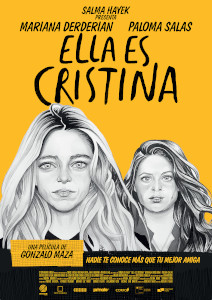
This Is Cristina (Ella Es Cristina) poster
Photo: Figa Films
One of the feature films in this year’s 19th Los Angeles Latino International Film Festival (LALIFF), part of the Festival’s Official Selection, was This is Cristina (Ella Es Cristina). The 82-minute Chilean film from Mar Humano and Primate Lab, in Spanish with English subtitles, was directed by Gonzalo Maza and distributed by Figa Films. Scroll down to watch a trailer.
Salma Hayek was executive producer along with José Tamez and Siobhan Flynn. The film received support from the Fondo de Fomento Audiovisual. The 2018 film, starring Mariana Derderian, Paloma Salas, Roberto Farias, Daniella Castillo, Nestor Cantillana, Alejandro Goic and Claudia Celedon, tells the story of two women in their thirties, Cristina and Susana, who have been best friends since high school. As their lives change their friendship suffers and is tested. There is a surprise ending. The film should be available at festivals and online beginning in September.
Despite the COVID-19 pandemic this year’s Los Angeles based Festival, established in 1997, included seven feature films and 23 short films from 12 countries. The festival took place May 5 to 31, 2020. The countries represented were Argentina, Australia, Brazil, Canada, Chile, Colombia, Cuba, Mexico, Peru, Spain, United States and Uruguay.
Other features included Paper Children and The Last Rafter. Shorts included: 1, 2, 3, All Eyes On Me Accents; Acuitzeramo; Ailin on the Moon; Baby; Blanes and St. Muller; Borrachero; Flesh; Flowers Within; Lady Justice; María; Miguel; Muy Gay Too Mexicano; Napo; Ode to the Beans; Rizo; Say You Will; Status Pending; The Undocumented Lawyer; and Wilderness.
An organization spokesperson declined to identify the names of the individuals responsible for selecting films for inclusion in this year’s festival. Funding, she said, is from “sponsors, donors and grants.” As of this writing the only contact information available on the event website is via a contact form. No street address or phone number are listed.
According to a press release for the festival “LALIFF is presented by the Latino Film Institute (LFI), a nonprofit 501(c)(3) organization with the mission to showcase, strengthen, and celebrate the richness of Latino lives through the audio-visual event. According to the LALIFF About Us page, “The Latino Film Institute (LFI) showcases, strengthens, and celebrates the richness of Latino lives by providing a pipeline, platform, and launching pad from our community into the entertainment industry.” It describes LALIFF as “dedicated to showcasing the entirety of human experience from the Latino perspective, whether through film, television, digital, music, art, or any other vehicle, regardless of platform.”
Posted by Elena del Valle on May 6, 2020
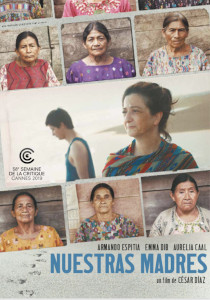
Nuestras Madres poster
Photo, video: Outsider Pictures
Nuestras Madres (Our Mothers), a 78-minute documentary style drama in Spanish with English subtitles from Outsider Pictures had its virtual theater release at 15 locations in the United States last week. The somber film was Winner Camera D’or, Cannes Film Festival and Belgian Entry to 92nd Academy Awards. Scroll down to watch a trailer.
It features Mexican actor Armando Espitia as Ernesto, a young anthropologist working for the Forensic Foundation in Guatemala in 2018 during the trial of the soldiers who sparked the civil war. Charged with identifying the bodies of the missing he has a personal mission. Emma Dib is Cristina, his mother.
The account of an older woman from a small village convinces Ernesto he has a promising clue to find his father, who went missing during the war. Although his mother and his boss urge him to leave well enough alone he presses forward.
César Díaz, director, heard from his mother about his father, also a “disappeared” guerrilla fighter. He began the project as a documentary about military massacres during the Guatemalan civil war in the 1970-80s. After meeting women in the villages where the fighting took place he turned it into a feature drama. According to promotional materials, their testimonies, often full of violent tales, reveal the story of Guatemala’s history as one of the first Central Intelligence Agency “Black Operations.”
“In Guatemala, fathers are absent as a general rule,” Díaz said in a press release (he was not available for a podcast interview). “Many children born of rape think that their father just left at some point. I therefore wanted the mother to reveal her secret, because it is a way of accepting and living with the consequences of what has happened. In a post-dictatorship, post-war situation, I think there must be collective acceptance, which can then be followed by individual moving on. Nuestras Madres is, to my knowledge, the first film to deal with this subject head-on.”
According to press materials for the film only 1 percent of the disappeared have been identified after over 20 years of searches. The genocide trial in the film is a mixture of many trials taking place, as is the uncovering of mass graves and returning the bodies to the families.
The film was made with the support of Centre du Cinéma et de l’Audiovisuel de la Fédération Wallonie Bruxelles Proximus Eurimages. Born in Guatemala in 1978 Díaz studied in Mexico and Belgium. He attended a screenwriting workshop at La Fémis (Ecole Nationale Supérieure des Métiers de l’Image et du Son, the FEMIS Film School) in Paris, France. He has been a fiction and documentary film editor for more than a decade. He directed the short documentary films Semillas de Cenizas screened in twenty international film festivals. Nuestras Madres is his first feature film.
Beginning May 1, 2020 Our Mothers became available nationally via local art house cinemas for $12 per ticket, split equally with the local cinema to help support them during the pandemic. As of this writing the theaters are: in California: Los Angeles at Laemmle Theaters, Davis at Varsity Theater, Larkspur at The Lark, Santa Ana at The Frida Cinema, San Diego at Digital Gym Cinema; in Denver, Colorado at SIE Film Center; in Florida: Fort Lauderdale/Hollywood at Fort Lauderdale International Film Festival, in Miami at Tower, in Tampa at Tampa Theater; in Michigan: Detroit at Cinema Lamont, Ann Arbor at Michigan Theater; in St Louis, Missouri at Webster University Film Series; Albuquerque, New Mexico at The Guild Cinema; in Buffalo New York at North Park Theater; in Cleveland, Ohio at Cleveland Cinematheque; and in Philadelphia, Pennsylvania at Cinespeak.
Posted by Elena del Valle on April 6, 2020

Video: Discovery en Español
Looking for more information on the COVID-19 pandemic in Spanish? At 9 p.m. E/P Wednesday April 8, 2020 Discovery en Español will air COVID-19: Pandemia 2020, a 43-minute special. The original program was in English. The Discovery en Español version will be in Spanish. Scroll down to watch a video clip in Spanish.
The special features suspenseful background music, news clips, domestic and international archive footage and on camera interviews with a handful of individuals from Mercatus Center at George Mason University, University College London, Council on Foreign Relations, The New York Times, and University Wisconsin-Madison.
The special outlines the general way the disease spread throughout China and other countries around the world in months, prompting a widespread quarantine in China, quickly mimicked by other countries.
It explains that the Center for Disease Control and Prevention (CDC) refused to adopt the COVID-19 test offered by the World Health Organization (W.H.O.), insisting on developing its own. This caused grave delays as the initial tests were faulty. According to one expert interviewed on the program flattening the curve efforts will result in the same number of people being stricken by the virus. It will take longer than without the social isolation measures.
The program was produced by ITN Productions for the Science Channel. The executive producers for ITN Productions are Ian Russell and Sarah Jane Cohen; Nick Powell is the producer. The executive producer for Discovery and Science Channel is Gretchen Eisele. The special will repeat on Sunday, April 12 at 10 p.m. and will also be available in the Discovery en Español Go app.
Posted by Elena del Valle on February 27, 2020
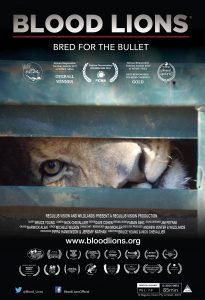
Blood Lions poster – click to enlarge
Photos, video: Blood Lions
There may be as many as 12,000 lions in 350 breeding farms in South Africa living a desperately sad existence, according to Pippa Hankinson. She became appalled at the conditions of the captive lions in a remote breeding farm she visited in South Africa in 2011. After researching the subject at length and finding there were many similar farms she set out to share her discovery with the world. Four years later Blood Lions, an 84-minute feature documentary became available internationally. Scroll down to see a trailer.
“After over a year of intensive research, it was apparent that very few people were aware of the full extent of the industry – neither abroad nor in South Africa,” Hankinson, producer, Blood Lions, said by email when asked about the film*. “I felt strongly that the world needed to know, and decided that a film would be the most expedient way to create global awareness around what I saw as being complete exploitation.”
About the target audience for the film she said, “Widely speaking, the target audience for Blood Lions is the general public – particularly the youth – around the world. More specifically we aim to educate the travel industry i.e. tour operators sending clients to South Africa, as well as to empower tourists and young volunteers to encourage them to make responsible and ethical choices when visiting this country. And lastly we invite all those in positions of influence around the world to watch the film, and to help elicit policy change which will ensure the protection of all predators (and indeed all our wildlife) from cruelty, exploitation and commercial practices which are harmful and disrespectful, and which create ‘markets’ for the abusive and unethical use of our wildlife.”
The goal? “Blood Lions was produced to shine a light on the insidious practices of predator breeding and canned lion hunting in South Africa, as well as associated activities such as interactive tourism and the lion bone trade to SE (south east) Asia. Our aim was to reach as broad an international audience as possible in order to build global awareness and knowledge around the industry. It was – and still is – a ‘call to action,’ not only to effect behavioural change around how we treat our wildlife, but also to precipitate change in policy through garnering support from the world’s most influential individuals and organizations. Ultimately, we hope to see an end to captive predator breeding.”
When asked how easy filming was she said, “Our main challenge when filming Blood Lions was to appear as ‘amateur’ as possible, whilst at the same time securing HD (high definition) quality documentary video footage, so our filming/production approach was to be as low key as possible. This meant only one camera person – using highly mobile camera/audio equipment – who often posed as a tourist. A ‘spy camera’ was used to capture certain scenes where a conventional camera might have aroused suspicion. The use of a stills camera that was also able to shoot video, was also very useful in keeping a low profile. Another critical component of the film was the challenge of obtaining imagery from volunteers or staff who working on the captive lion breeding farms, who had the ability to get unique access to ‘behind the scenes’ animal and human behaviour. Suspicious predator breeding and hunting farm operators made life very difficult for us when they tipped off their colleagues that ‘greeny’ photo journalists were asking questions and capturing images on their properties. Some of the farms were therefore expecting us, and after a lot of threats, demanded that we leave the premises immediately we arrived. It was on these occasions that our hidden camera paid off. When we visited the hunting farm, our team posed as a private small film crew who were following an American client to make his own personalised African hunting safari video. This worked until such time that canned lion hunting operators once again became suspicious, and went so far as threatening to ‘kill us’ which forced our camera team to immediately leave their fenced hunting farm.”
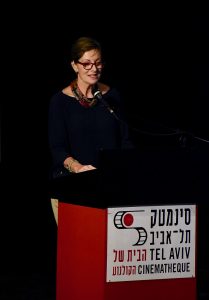
Pippa Hankinson, founder, Regulus Vision Pty Ltd
Many farm raised captive animals are hunted. When asked why she focused on lions the film producer said, “As you say, many farms raise captive animals to be hunted, but there is a ‘double-edged sword’ to the breeding of predators as they are not only bred to be hunted, but for their bones to be exported to supplement the ‘tiger bone trade’ in SE Asia. No other wild animals are hand-raised and bottle fed…simply for the bullet. Furthermore, most internationally recognised lion ecologists agree that the captive lion breeding industry has no conservation value whatsoever. Although captive hunting statistics have decreased, the demand for lion bones from Asia has increased dramatically over the last few years, leading to fears that this demand will inevitably put pressure on wild populations, as poaching increases and the illegal trade and trafficking intensifies.
Although my passion for wildlife extends to all animals, it seemed incomprehensible to me that these magnificent, iconic predators should be exploited in such a way. Lions are a keystone species at the top of the food chain, and they play a critical role in our ecosystem. There is no doubt in my mind that they are wild creatures, and that all wild species should be allowed to live out their lives in their natural habitat, and not forced into captivity to be mass bred for commercial purposes. To lion breeders in South Africa they are seen simply as commodities to be used to generate a lucrative income through interactive tourism and volunteering, trophy hunting and the sale of their body parts. It is now estimated that there are between 8,000 and 12,000 predators currently being held captive in over 350 breeding facilities across South Africa… very similar to ‘puppy mills’ in the USA. They lead heartbreaking lives and the cycle never ends.
Lion cubs born in captivity in South Africa are removed from their mothers within the first week of birth, and are passed off as ‘orphans’ or ‘rescues’. This practice of removing the cubs forces the females into intensive breeding cycles where lionesses produce up to five times more litters of cubs than they would in the wild. These tiny cubs are bottle fed, petted and hand-reared by paying tourists and volunteers who are led to believe that they are supporting authentic conservation projects which will rehabilitate these predators back into the wild. Nothing could be further from the truth. When the cubs grow too old for ‘pay and play’ activities, many are moved to facilities that offer ‘walking with lions’ tourist attractions. These sub-adult lions are often sedated, and trained in the same way as circus animals, to climb trees and pose for ‘selfies’ with paying tourists: facebook.com/BloodLionsOfficial/videos/1039594396154923/
Once these lions are considered too dangerous to be in contact with humans, some are sent to canned (captive) hunting facilities where they are shot in confined enclosures by trophy hunters. Others are sold to zoos or traders as breeding stock for new facilities, or private collections around the world. Completing the cycle of exploitation, lions that are not used for the above purposes are euthanized or slaughtered for their body parts to be exported to Asia to supplement the ‘tiger bone trade.’ The skeletons are utilised for medicinal and aphrodisiacal purposes in the production of what is called ‘tiger wine’ and ‘tiger cake,’ and also for use in ‘tiger bone jewellery’: facebook.com/BloodLionsOfficial/videos/1062460323868330/. This trade is also extremely worrying from a welfare perspective, as animals shot for their trophies in canned hunts are required to be in a reasonably good condition, whereas lions bred for the bone trade are bred intensively with little or no consideration towards their health or welfare: facebook.com/BloodLionsOfficial/videos/1447633032017722/”
Eighteen months after her deeply disturbing visit to a South African lion breeding farm in 2011, Hankinson founded Regulus Vision Pty Ltd to produce Blood Lions. She remains actively involved in the Blood Lions Campaign launched after the film’s release, “in order to continue to create further global awareness around the exploitation of the captive lion breeding industry.” The Blood Lions team members are Bruce Young and Nick Chevallier, directors; Hankinson and Jeremy Nathan, producers; Ian Michler, special consultant and lead character; Wildlands and Andrew Venter, executive producers; Bruce Young, script; Nick Chevallier, camera; and Dave Cohen, editor.
In 2015, Blood Lions premiered at the Durban International Film Festival in South Africa. Engagements with MSNBC and Discovery International followed. The film has appeared in 180 countries and territories around the world. It was screened at 17 international film festivals and hosted by the Blood Lions team in 25 countries. In the United States Blood Lions is available online at the PBS shop, Amazon, Ecostreamz and the Wildlife Conservation Channel.
*Text edited for style, length and clarity.
Posted by Elena del Valle on January 15, 2020
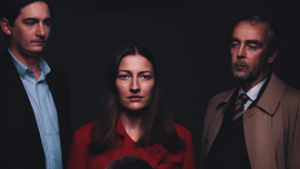
The Victim, a Scottish thriller
Photo, videos: courtesy of KCET
KCET, a Southern California public station, will premiere Austrian, French and Scottish programming this month. The Victim, a four-part Scottish thriller series, Resistance, a French World War II series, and Vienna Blood, an Austrian mystery series will air locally beginning in January. After their on air premier the programs will be available on the station website. Scroll down to watch trailers.
The Victim first aired in the United Kingdom on BBC One April 2019. The engaging and thought provoking thriller explores age old issues of whether the punishment fits the crime as well as the new ethics of individual responsibility for posts on social media. It stars Kelly Macdonald (Boardwalk Empire, No Country for Old Men) as Anna Dean who is accused of leaking her son’s suspected murderer’s identity online and conspiring to have him killed. John Hannah (Four Weddings and a Funeral, Agents of S.H.I.E.L.D.) plays Craig Myers, a hard working family man seeking prove his innocence.
The first episode aired January 7, 2020. Resistance is scheduled to air Tuesday, January 14 at 10 p.m. PT and Vienna Blood should air January 23 at 10 p.m. PT.
Resistance, based on true events, (in French with English subtitles) portrays the story of “a group of young French heroes fighting for freedom from German Nazi occupation in World War II” who join forces to produce a newspaper. According to a press release, the program is part of Walter Presents, a curated collection of award-winning international dramas hand-picked by Walter Iuzzolino, “a TV connoisseur who has scoured the globe for compelling hits.”
In Vienna Blood, reminiscent of Sherlock Holmes with some elements of romance, a student of medicine and Sigmund Freud and an Austrian detective team up to solve murder cases in early 1900s Vienna. It features Matthew Beard (The Imitation Game) and Juergen Maurer (Vorstadtweiber). The final four episodes were my favorites.
According to promotional materials, KCET offers cultural and educational programs in Southern and Central California, including local programming and television programs from around the world. Throughout its 54-year history, KCET has won hundreds of major awards.
Posted by Elena del Valle on October 30, 2019
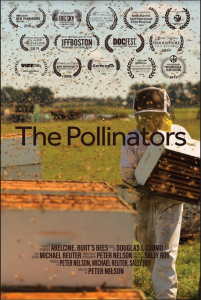
The Pollinators poster
Cinematographer Peter Nelson dedicated countless hours to filming bees, traveling to 14 states, following bee managers and their bees; and interviewing 26 people in the making of The Pollinators, a 92-minute film about bees and their role in agriculture today. Its festival premiere was at the Big Sky Documentary Film Festival. To date it has been screened at 18 festivals. He has already taken home seven festival awards. Scroll down to watch a trailer for The Pollinators*.
When asked by email what prompted him to make a film now he said, “I am a backyard beekeeper for over 30 years now and also a cinematographer by profession. I also have a great interest in food and agriculture and felt the story of migratory beekeepers and our dependence upon managed honey bees was not well known I was compelled to tell this story due to a collisions of all these passions.
Losses among commercial beekeepers are very high and range from 30 to 50 percent or more. This is not sustainable long term and this matters to all of us because us our dependence upon the managed bees for so much of our food. One of every three bites is something pollinated by a bee, so this is really important if you like to eat. We are in a time of peril for the bees (and also many other insects) and I wanted to take a look at this and tell this story.”
The target audience? Beekeepers, of course as well as people interested in the environment, farming, foodies and gardeners. The film includes bee close ups and beautiful images of the insects in flight as well as disturbing shots of thousands of dead bees.
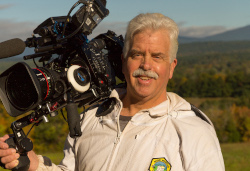
Peter Nelson, director, The Pollinators
“Filming bees was a challenge, but also a lot of fun,” the filmmaker said. “I wanted to try and show bees in a way I had not really seen before as the wonderful beautiful insects they are. Many people are afraid of bees and I understand that as they are a stinging insect. Unlike yellow jackets, honey bees will sting only as a last resort and they die in the process so honey bees are not aggressive for the most part. Honey bees are also incredibly beautiful and complex creatures and I wanted to try and show bees to audiences in a new way and share how wonderful and graceful honey bees really are. I used a lot of very high speed photography (up to 1560 frames per second) to show bees in super slow motion flying, taking off, landing and just being beautiful in their natural environment.
Bees fly really fast and so are very challenging to film, especially in macro close up. My experience as a beekeeper for many years, gave me an advantage with this by understanding a bit about bee behaviors and the way they fly, land and their rhythms to some extent. It also required a lot of patience and a steady hand to keep the bees in focus at such shallow depth of fields.
I used Vision Research Phantom cameras and macro lenses provided by AbelCine for the ultra slow motion. The specialty cameras were provided by AbelCine as part of a grant for this project. My main camera was a Canon c300 Mk II and a 17-120 cinema zoom which I own and also some prime lenses for night. I also cannibalized one of my backyard bee hives to be able to stick a lens right inside the hive for a unique view of the bees inside their homes.”
Regarding funding and support he said, “We have a tremendous amount of sweat equity and some personal funding in the film. Being a cinematographer, I could go shoot pretty much as I needed to so was able to respond quickly to developments and shoot as needed. We also had some early financial support from Burt’s Bees, The Schumann Media Center helped us with funding. We also won a Doc Pitch competition from the Paley Center.
AbelCine gave us an ‘in-kind’ grant towards specialty camera equipment and lenses. Michael Reuter, the editor, producer and co-owner of EditBar helped us tremendously in post production right through completion.”
The only people who were paid were crew members for their services, he said, and no one who appears in the film was compensated in any way for his or her appearance nor was anyone paid for access.
“I wanted to bring this important story to audiences, to try and connect people to their food, where it comes from and a bit of what is involved in growing it,” he said when asked what he hoped to accomplish. “I also wanted to raise awareness and try to explain some of the causes of pollinator decline. If we can connect dots for people about the role of pollinators to our food system in some way, I would consider that a success.”
The producers were Sally Roy, Peter Nelson and Michael Reuter. Nelson was director of photography. At the time of this writing the project leaders were starting a theatrical release through Demand.Film, a crowd sourced distribution platform designed to make films available to cinemas across the United States, Canada, Australia, New Zealand, United Kingdom, Ireland and Germany over the next months. The goal is for the film to screen in one day events across the country in many places that would not likely screen independent documentaries. A national day of screenings is planned for Nov 6, 2019 in the United States (more at //us.demand.film/the-pollinators/). Broadcast, streaming, video on demand (VOD) and educational distribution venues have not been determined yet.
*Photos, video: Poster image and video courtesy of Peter Nelson, photo of Peter Nelson courtesy of Eric Krieger
Posted by Elena del Valle on October 23, 2019
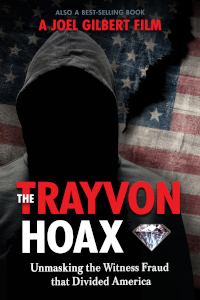
The Trayvon Hoax
Photos, video: Highway 61 Entertainment
Los Angeles based filmmaker Joel Gilbert set out to produce a documentary about the rise of Andrew Gillum, a past Florida gubernatorial candidate. He ended up writing a book and making a film about the death of Trayvon Martin and the trial of George Zimmerman in Sanford, Florida. The world premiere debut of The Trayvon Hoax: Unmasking the Witness Fraud that Divided America, a two-hour film, was at The National Press Club in Washington DC September 16, 2019. Scroll down to watch a video clip of the film.
When asked by email what prompted him to search this topic, write a book and make a film the director said, “I had followed the 2012 shooting death of seventeen-year-old Trayvon Martin and the subsequent trial of George Zimmerman from afar and, like many others, I had grave concerns about the lynch mob mentality that drove the case. Only after I started researching the project did I realize I had stumbled into the most spectacular case of identity fraud in modern American judicial history. The fraud resulted in the seminal race hoax of the Obama years. I call it ‘The Trayvon Hoax.’ It is appalling that six years after the Zimmerman trial so much information was left for me, an independent filmmaker, to discover. If the media had wanted to find the truth, it was there for the plucking. I was able to uncover it simply by reading publicly available information from the legal proceedings and following up on what I read. How is it possible no one in the media chose to do what I did? The answer is simple. The media did not want to know. The truth would not have advanced their fear-fueled racial agenda.
The Zimmerman trial literally divided America. Prior to the trial in 2012, both blacks and whites rated race relations as positive. This has been negative ever since. It lead directly to the ‘Ferguson Effect,’ a crime disaster for black neighborhoods with homicides up 33 percent. Also, the modern era of fake news and race hoaxes started with this case. Nothing has been more damaging to the United States than this trial and no one has suffered more from this ongoing hoax than the black youth of America.”
It took about 11 months to complete the film and book project, the author said. He dedicated the first five months to the investigation and filming. The next six months were for film editing and writing the 272-page book. He declined to disclose the budget or the source of funding for his project, saying, “We are a private independent film production company and we don’t disclose our budgets related to any project. However, there was no third party funding or donations for this film.”
“This Trayvon Martin shooting and Zimmerman case is still talked about and on everyone’s mind,” the filmmaker said when asked why he thinks the topic is relevant today, years after the trial took place. “Its why Black Lives Matter was formed. Presidential candidate Kamala Harris recently tweeted that Trayvon Martin started a movement. Well, that movement led to massive racial division and harm in America, all because of a fake witness. All the fake news and race hoaxes that continue to this day started with the Zimmerman trial, it was ground zero. Also, Sybrina Fulton, Trayvon Martin’s mother, is running for Miami-Dade Commissioner. The film provides evidence that Ms. Fulton knew about the fake witness in the case, but allowed it to go forward anyway. She did not alert the media or the judge even though she knew Rachel Jeantel was not Diamond Eugene as she claimed to be. Ms. Fulton was just endorsed by Hillary Clinton on Twitter who asked her 25 million followers to contribute to her campaign. Corey Booker endorsed her as well. I have no doubt that the Democrats are planning to bring Ms. Fulton to the Democrat convention once again in 2020 to help push their race based narratives of ‘black-men-are-targeted-by-racist-whites and cops’ to try to secure 95 percent of the black vote.”
When asked if he compensated Zimmerman (or anyone else) in any way for the on camera interview he replied, “As is customary for interviews with public figures who are featured in documentaries in extended interviews, Zimmerman was paid an appearance fee for his time. Zimmerman did not testify in his own trial, so The Trayvon Hoax: Unmasking the Witness Fraud that Divided America provides his account for the first time.”

Joel Gilbert in a scene from the film
To the question “Did you reach out to the teenager’s family, Zimmerman’s attorney, the prosecutor, witnesses such as Martin’s girlfriend who testified or anyone involved with the case (other than Zimmerman’s on camera interviews) to ask for their comments on your findings?” he replied, “I reached out to Zimmerman’s attorneys early on and got some help with background questions mostly. Mark O’Mara initially expressed skepticism that Rachel Jeantel was a fraud. “She was such a terrible witness,” he told me rhetorically, “why would anyone use her as a substitute?” I explained to O’Mara that those who knew the depth of the evidence exonerating George, his broken nose, his recorded screams for help, Johnathan Good’s testimony, never expected to get a conviction. Nothing any fake witness could say could overcome the hard evidence, I told him. But then again conviction was never the point; an arrest was what mattered. For Crump, an arrest opened the door to a civil suit. For the State of Florida, an arrest kept the mob at bay. For Barack Obama’s Justice Department, an arrest meant getting out the black vote for Obama in 2012 in Florida and hopefully nationwide. For Al Sharpton and his crowd of Leftists, an arrest and trial advanced their racially charged agenda.”
The film and book are available online at Amazon.com and other websites that sell DVDs, books and eBooks. The film is available as a DVD and for live streaming on demand on Vimeo.com.
“I hope that by exposing the truth about this major legal case that divided America based on a fraudulent witness, that it might result ultimately in national healing,” he said when asked what he hoped to accomplish from the book and film. “America got played by an epic race hoax that divided us for no reason. Americans are all brothers. Black and white, we are all brothers. My hope is to show how politicians and the media used Trayvon Martin’s tragic death to tear us apart, when our true aspirations have always been to come together as one nation.”
According to his website biography Gilbert is president of Highway 61 Entertainment, a political commentator and foreign policy analyst. Other films listed to his credit include Dreams from My Real Father (2012), There’s No Place Like Utopia (2014), Trump The Art of the Insult (2018), Farewell Israel (2008) and Atomic Jihad (2010).
Posted by Elena del Valle on July 15, 2019
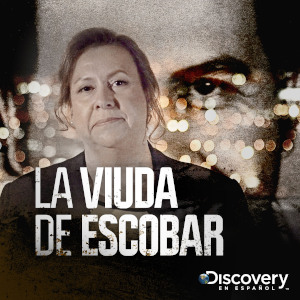
Photo, video: Discovery en Espanol
For viewers curious about the life and heirs of Pablo Escobar, thought to have been one of the most infamous and wealthiest criminals of the 1980s and 1990s, Discovery en Español presented a two hour documentary (the screener was 45 minutes long) in Spanish about his wife, Maria Isabel Santos. The program aired at 9 p.m. Eastern and Pacific time July 14, 2019 and should be available through the network’s GO app beginning today. Scroll down to watch a trailer in Spanish.
Known as La Tata she was born Victoria Henao Escobar. Twenty-five years after Escobar’s death she broke her self imposed silence for the Telegramme Media documentary, a Canadian project. The film was produced by Eric Hebert and Quebecor in 2018.
Narrated in the first person by La Tata the film features archival photos, family home video and newsreel segments. She revisits locations of significance to her past such as Monaco, the building where she and her husband lived in a penthouse suite, and the home in Panama City, Panama where she gave birth to her daughter. She explains that her husband, more than a decade her senior, began pursuing her romantically when she was only 13.
Posted by Elena del Valle on November 7, 2018



Fiddlin’ poster
Video: Fiddlin Films, Fort Lauderdale Int’l Film Festival (FLiFF)
Photos: Fiddlin Films
Sisters Julie Simone and Vicki Vlasic, natives of the Appalachian Mountains, returned home to film during the 80th Anniversary of the World’s Oldest and Largest Fiddler’s Convention, the first filmmakers permitted to do so in the history of the event. The result is Fiddlin’, an uplifting showcase of old time and bluegrass music and some of its musicians. The 96-minute film required two and a half years to make. It will premier in Florida at 6 p.m. November 14, 2018 at Savor Cinema Lauderdale as part of the Fort Lauderdale International Film Festival. Scroll down to watch a trailer.
“We wanted to shine a positive light on the true beauty of this area with it’s traditions, culture, music and authentic people,” said Simone, director, Fiddlin’, in an email about the making of the documentary. “Because we were a small crew, we threw cameras at our nieces and nephews, my mom cooked for everyone and my dad set up camp for us. This was a passion project and we all came together to make Fiddlin’ happen.”
They filmed with a budget below $500,000 in Galax, Virginia and other small towns in Southwest Virginia as well as in the Nashville, Tennessee area. Funding sources included a Kickstarter campaign, a grant from the Rogovy Foundation, donations from friends and family and the sisters.
“We recruited our family to help work on the project as well as hiring a DP and Audio Recordist from North Carolina,” said Vlasic, producer of the film, by email. “Our kids were holding booms, lights, carrying equipment and filming on additional cameras. Our parents cooked for the entire crew. Julie and I have worn many hats as we navigated the process of getting our film made.
Julie and I grew up in this Appalachian region and spent our summers attending the Old Fiddler’s Convention in the neighboring town of Galax. After living in major cities for many years, Julie realized that this cultural event that we had always taken for granted was worthy of sharing with a larger audience. We had also started noticing that in recent years, there had been an enormous change in the demographics of the festival-young kids were now playing the traditional music in droves. In our youth, the musicians were only older people. Even more inspiring was seeing that the young people were jamming and hanging out with their elders and carried instruments instead of smartphones.”

Musicians Ivy Phillips and Annabelle Watts
When asked to describe the music Vlasic said, “Old Time music was the music played in these mountains when the first settlers came from England, Ireland, Wales and Germany and began playing with the African slaves who introduced the banjo to our country. The combination of their music became known as Old Time music. In 1947, Bill Monroe and the Bluegrass Boys (so named as they came from the state of Kentucky) began to take breaks on individual instruments and to improvise and try to outdo the player before them. This was the birth of Bluegrass Music. Monroe’s brother started using picks on his fingers to play the banjo which also differentiated the sound from Old Time. Many consider Bluegrass to be a ‘fancier’ style of music with some licks borrowed from blues and jazz music. Bluegrass later evolved into rock and roll when Elvis Presley recorded Bill Monroe’s ‘Blue Moon of Kentucky’ as his first record. Country music was also born out of much of this Mountain music.”
Simone grew up on a farm in the Blue Ridge Mountains of Virginia. Prior to making the independent film she enrolled in a gorilla style film making class where she wrote, directed and acted in multiple short films. After motherhood and divorce, she turned her attention to the camera. On a trip to Cannes, Julie directed, filmed, and appeared as herself in Cannes Without a Plan, a comedic reality and television pilot about divorce and being a single mom.
Fiddlin’ had its world premiere in March 2018 at San Louis Obispo, California, where it won the Audience Award. It has won multiple awards to date. The Florida screening will be the final one this year. Next year, the producers expect to participate in more screenings and announce a release date.

























